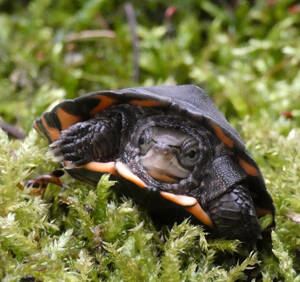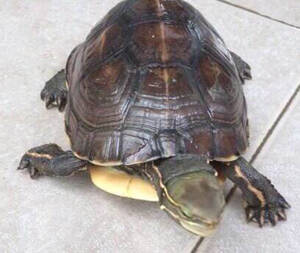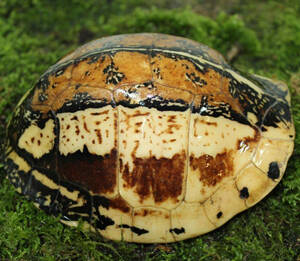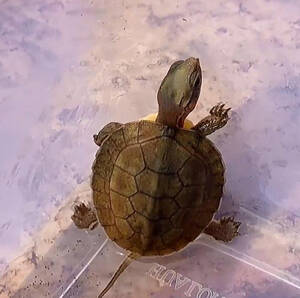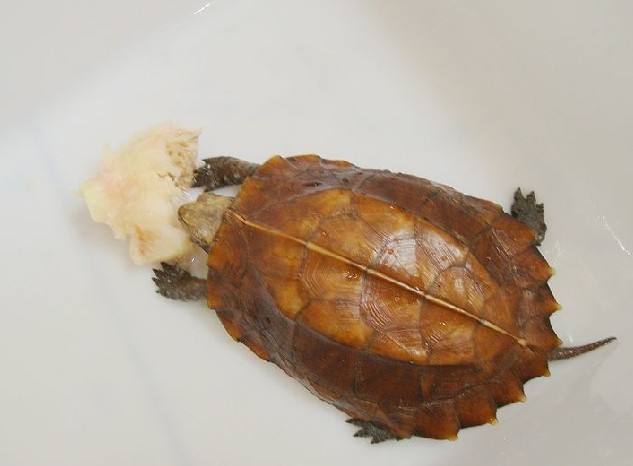Cuora zhoui
IUCN
LCBasic Information
Scientific classification
- name:Cuora zhoui
- Scientific Name:Cuora zhoui,Zhou`s Box Turtle,Black box turtle, black turtle
- Outline:Testudines
- Family:Testudinidae B.turtle
Vital signs
- length:16-16.5cm
- Weight:800-1000g
- lifetime:30-40years
Feature
Carapace is black or earthy black, with a tiny notch between the left and right hip shields
Distribution and Habitat
Zhou's box turtle is endemic to China and is distributed in Guangxi (Nanning area) and Yunnan.
Appearance
The head is narrow, the snout is pointed and the end is rounded and blunt, the orbital diameter is approximately equal to the distance from its front edge to the tip of the snout (i.e. the length of the snout); the upper jaw is obviously hooked, slightly beyond the lower jaw, and the jaw edge is serrated. The skin on the back of the head is smooth, and the skin on the back of the neck is covered with warts.
The carapace is oblong and 160-165 mm long. The holotype is 125 mm wide and the shell is 55 mm high. The front edge of the carapace is relatively flat, with a very small notch at the cervical shield, and the rear edge is rounded. The ninth to eleventh marginal shields are slightly serrated; there is a very small notch between the left and right anal shields; the edges on both sides are relatively straight, and the rear section is slightly inclined outward. There are 5 vertebral shields, and the front edge of the first vertebral shield is the widest, which can reach the second mar
Details
Zhou's Box Turtle is called Zhou's Box Turtle in foreign language, and has no subspecies.

Zhou's Box Turtle is named after Zhou Jiufa, the director of Nanjing Wulongtan Park, who discovered this turtle species in February 1990.
The living habits of wild Zhou's box turtles have not been recorded in detail. However, judging from its morphological characteristics, the turtle lives in mountainous areas, mountain streams, and small rivers. Under artificial breeding conditions, Zhou's box turtles like to live in water. When the ambient temperature is above 20℃, they can eat normally; when the ambient temperature is 15-19℃, they move less, sometimes eat, sometimes stop eating; stop eating below 14℃; hibernate around 10℃; when the ambient temperature is above 5℃, Zhou's box turtles can hibernate normally. There are no detailed records of the feeding habits of wild Zhou's box turtles. Under artificial breeding conditions, Zhou's box turtles eat lean pork, fish, poultry offal, small insects, etc. No plant-based food has been seen.
Zhou's box turtles have estrus and mating behavior in spring and autumn every year. In mid-May, the male turtle was first seen chasing the female turtle. During the chase, the male turtle sometimes stayed in front of the female turtle and stretched out his head to stop the female turtle from moving forward. If the female turtle refused, he stretched out his head to bite the male turtle's head and front legs, and the female turtle sometimes retreated and avoided; if the female turtle accepted the male turtle, it would crawl and lie still, and the male turtle would climb onto the female turtle's back from the side or back to mate. During the mating process, the male turtle stretched out his head and opened his mouth. The chasing phenomenon continued until early July; there was no chasing phenomenon in the hot summer season, but there was chasing phenomenon again in early September, and the water temperature was 24-28℃. Mating behavior occurred in early June, and the egg-laying period was from May to August every year. 5-6 eggs were laid each time, and the eggs were white and oval. The eggs are 42-42.8 mm long, 23.7-24.3 mm in diameter, and weigh 15.8-16.3 g. If sperm spots appear within two days, they are all fertilized eggs. The eggs are shallowly buried in vermiculite for natural incubation. The incubation temperature is between 27-31°C, and 90% of the time the incubation temperature is between 29-30°C. The total incubation time is 72 days.
Due to the destruction and reduction of the habitat and breeding environment, the difficulty of natural proliferation, and the high economic value, Zhou's box turtle has been captured repeatedly, and wild resources have been severely damaged.
Listed in the "Red List of Endangered Species of the World Conservation Union" (IUCN 2000 ver 3.1) - Critically Endangered (CR).
Listed in Appendix II of the Convention on International Trade in Endangered Species of Wild Fauna and Flora (CITES).
Listed in the China Red List of Biodiversity - Vertebrate Volume (Reptiles) - Critically Endangered (CR).
Listed in the List of Terrestrial Wildlife with Beneficial or Important Economic and Scientific Research Values Protected by the State, issued by the State Forestry Administration of China on August 1, 2000.
Listed in the second level of China's List of National Key Protected Wildlife (February 5, 2021).
Protect wild animals and stop eating game.
Maintaining ecological balance is everyone's responsibility!



